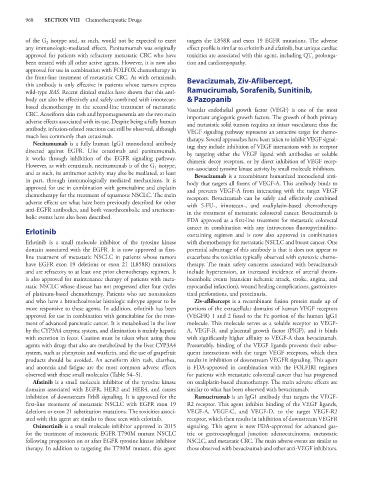Page 982 - Basic _ Clinical Pharmacology ( PDFDrive )
P. 982
968 SECTION VIII Chemotherapeutic Drugs
of the G isotype and, as such, would not be expected to exert targets the L858R and exon 19 EGFR mutations. The adverse
2
any immunologic-mediated effects. Panitumumab was originally effect profile is similar to erlotinib and afatinib, but unique cardiac
approved for patients with refractory metastatic CRC who have toxicities are associated with this agent, including QT prolonga-
c
been treated with all other active agents. However, it is now also tion and cardiomyopathy.
approved for use in combination with FOLFOX chemotherapy in
the front-line treatment of metastatic CRC. As with cetuximab, Bevacizumab, Ziv-Aflibercept,
this antibody is only effective in patients whose tumors express
wild-type RAS. Recent clinical studies have shown that this anti- Ramucirumab, Sorafenib, Sunitinib,
body can also be effectively and safely combined with irinotecan- & Pazopanib
based chemotherapy in the second-line treatment of metastatic Vascular endothelial growth factor (VEGF) is one of the most
CRC. Acneiform skin rash and hypomagnesemia are the two main important angiogenic growth factors. The growth of both primary
adverse effects associated with its use. Despite being a fully human and metastatic solid tumors requires an intact vasculature; thus the
antibody, infusion-related reactions can still be observed, although VEGF signaling pathway represents an attractive target for chemo-
much less commonly than cetuximab. therapy. Several approaches have been taken to inhibit VEGF signal-
Necitumumab is a fully human IgG1 monoclonal antibody ing; they include inhibition of VEGF interactions with its receptor
directed against EGFR. Like cetuximab and panitumumab, by targeting either the VEGF ligand with antibodies or soluble
it works through inhibition of the EGFR signaling pathway. chimeric decoy receptors, or by direct inhibition of VEGF recep-
However, as with cetuximab, necitumumab is of the G isotype, tor–associated tyrosine kinase activity by small molecule inhibitors.
1
and as such, its antitumor activity may also be mediated, at least Bevacizumab is a recombinant humanized monoclonal anti-
in part, through immunologically mediated mechanisms. It is body that targets all forms of VEGF-A. This antibody binds to
approved for use in combination with gemcitabine and cisplatin and prevents VEGF-A from interacting with the target VEGF
chemotherapy for the treatment of squamous NSCLC. The main receptors. Bevacizumab can be safely and effectively combined
adverse effects are what have been previously described for other with 5-FU-, irinotecan-, and oxaliplatin-based chemotherapy
anti-EGFR antibodies, and both venothrombolic and arterioem- in the treatment of metastatic colorectal cancer. Bevacizumab is
bolic events have also been described.
FDA approved as a first-line treatment for metastatic colorectal
Erlotinib cancer in combination with any intravenous fluoropyrimidine-
containing regimen and is now also approved in combination
Erlotinib is a small molecule inhibitor of the tyrosine kinase with chemotherapy for metastatic NSCLC and breast cancer. One
domain associated with the EGFR. It is now approved as first- potential advantage of this antibody is that it does not appear to
line treatment of metastatic NSCLC in patients whose tumors exacerbate the toxicities typically observed with cytotoxic chemo-
have EGFR exon 19 deletions or exon 21 (L858R) mutations therapy. The main safety concerns associated with bevacizumab
and are refractory to at least one prior chemotherapy regimen. It include hypertension, an increased incidence of arterial throm-
is also approved for maintenance therapy of patients with meta- boembolic events (transient ischemic attack, stroke, angina, and
static NSCLC whose disease has not progressed after four cycles myocardial infarction), wound healing complications, gastrointes-
of platinum-based chemotherapy. Patients who are nonsmokers tinal perforations, and proteinuria.
and who have a bronchoalveolar histologic subtype appear to be Ziv-aflibercept is a recombinant fusion protein made up of
more responsive to these agents. In addition, erlotinib has been portions of the extracellular domains of human VEGF receptors
approved for use in combination with gemcitabine for the treat- (VEGFR) 1 and 2 fused to the Fc portion of the human IgG1
ment of advanced pancreatic cancer. It is metabolized in the liver molecule. This molecule serves as a soluble receptor to VEGF-
by the CYP3A4 enzyme system, and elimination is mainly hepatic A, VEGF-B, and placental growth factor (PlGF), and it binds
with excretion in feces. Caution must be taken when using these with significantly higher affinity to VEGF-A than bevacizumab.
agents with drugs that also are metabolized by the liver CYP3A4 Presumably, binding of the VEGF ligands prevents their subse-
system, such as phenytoin and warfarin, and the use of grapefruit quent interactions with the target VEGF receptors, which then
products should be avoided. An acneiform skin rash, diarrhea, results in inhibition of downstream VEGFR signaling. This agent
and anorexia and fatigue are the most common adverse effects is FDA-approved in combination with the FOLFIRI regimen
observed with these small molecules (Table 54–5). for patients with metastatic colorectal cancer that has progressed
Afatinib is a small molecule inhibitor of the tyrosine kinase on oxaliplatin-based chemotherapy. The main adverse effects are
domains associated with EGFR, HER2 and HER4, and causes similar to what has been observed with bevacizumab.
inhibition of downstream ErbB signaling. It is approved for the Ramucirumab is an IgG1 antibody that targets the VEGF-
first-line treatment of metastatic NSCLC with EGFR exon 19 R2 receptor. This agent inhibits binding of the VEGF ligands,
deletions or exon 21 substitution mutations. The toxicities associ- VEGF-A, VEGF-C, and VEGF-D, to the target VEGF-R2
ated with this agent are similar to those seen with erlotinib. receptor, which then results in inhibition of downstream VEGFR
Osimertinib is a small molecule inhibitor approved in 2015 signaling. This agent is now FDA-approved for advanced gas-
for the treatment of metastatic EGFR T790M mutant NSCLC tric or gastroesophageal junction adenocarcinoma, metastatic
following progression on or after EGFR tyrosine kinase inhibitor NSCLC, and metastatic CRC. The main adverse events are similar to
therapy. In addition to targeting the T790M mutant, this agent those observed with bevacizumab and other anti-VEGF inhibitors.

